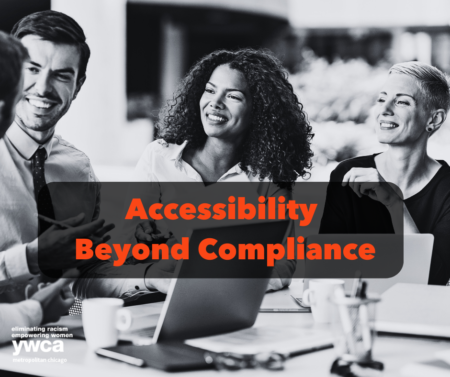Accessibility Beyond Compliance

To truly be inclusive for people with disabilities, organizations must strive for accessibility beyond mere compliance. Accessibility should be built into an organization’s short and long term diversity, equity, and inclusion strategic plans. Some workplaces—including the federal government—are adopting a DEIA (diversity, equity, inclusion, and accessibility) approach that can fully realize the abilities and contributions of all workers. Going beyond compliance to develop and embody a DEIA strategy means recognizing that each employee’s personal (not just professional) experiences shapes how they can uniquely contribute to the workplace.[1]To truly embody equity, employers need to understand disability through an intersectional lens. Intersectionality recognizes that a person can have more than one identity that subjects them to myriad barriers and biases on a day-to-day basis. For instance, women of color with disabilities are at the triple intersection of being people of color, women, and living with a disability. The combined barriers and biases that result from how systems inequitably treat these women can prevent them from accessing the socioeconomic resources and mobility that could help them get ahead in the workplace and beyond.The intersection of accessibility and racial justice is just one topic that organizations can explore by working with Inclusion Chicago. To start that work, we’ve put together this list for organizational leaders to consider, particularly those who want to fully embody accessibility in the workplace and unleash the full potential of all employees. All of these possibilities are built on a crucial foundation: people with disabilities (especially women of color) need employers who are willing, able, and ready to listen deeply.
- Operationalize accessibility during the onboarding process:
- Employers should engage in more inclusive workspace design by asking new hires and existing employees how their workspace can be most effectively set up for them as individuals.
- Clearly articulate your diversity, equity, inclusion, and accessibility policy during both the application and hiring process. Make sure this policy is also disclosed in your employee handbook.
- Review and understand the types of accommodations your company offers for people with disabilities, and ensure all staff in managerial roles do too:
- According to the Job Accommodation Network, 50% of accommodations are free, and nearly all the rest have a one-time cost under $300.[2] Some examples of low-cost accommodations are providing written instructions to an employee with memory struggles due to a learning disability (rather than relying on verbal discussion), and providing flexible start and break times to someone with a chronic condition that requires frequent medication.
- List the accommodations and assistive technology your workplace provides or is willing to provide before hiring and across the workplace so that employees are aware these accommodations are available to them. Employees may pass up on opportunities otherwise. For example: verbal and written instructions, live auto generated caption on all web events, electric wheelchair, color-coded keyboards, refreshable Braille displays, specialized screen reader software, assistive listening devices, and speech recognition technology.
- Create employee resource groups (ERGs) for people with disabilities, to encourage peer support, mentorship, and sponsorship across the company.
- Flexible work schedules:
- Flexible hours allow employees to attend medical appointments without having to take additional time off.
- Remote work options:
- A person living with a disability may need to balance their work schedule by working remotely a few days out of the week, particularly if they are experiencing a physical disability such as chronic pain.
- Working from home allows employees to create an environment that is comfortable and best-suited to their individual needs. For instance, employees who rely on service animals may find an office at home more effective and efficient.
- Commuting can be time-consuming, costly, and physically and emotionally uncomfortable for some people with disabilities. Working from home minimizes those challenges.
- Know what health benefits you’re offering and ensure they’re robust. For instance, do your healthcare plans cover pre-existing conditions like vision or hearing differences, intellectual disabilities, or mental health disorders?
- Inclusive employee training:
- Train managers so they know how to support, proactively include, and integrate team members with disabilities in organizational and team processes. Make sure this training encompasses invisible disabilities that are often overlooked, and covers microaggressions people with disabilities often face.
- Provide training to employees so they know that support is available, and what that support actually looks like.
- Train front of office staff on greeting and assisting people with vision and hearing differences.
- Provide avenues for promotion to women of color with disabilities through leadership training and specific professional development opportunities.
- Ensure your company’s website is inclusive to job applicants, clients, and other stakeholders with disabilities, especially considering font, colors, animations, sounds, and other sensory aspects.
Sources/Resources
- “Women in the Workplace 2022” (McKinsey & Company)
- Women of Color in the Workplace, “Women of Color Facing Disabilities in the Workplace Report 2022” (draft)
- “Accomodation and Compliance: Low Cost, High Impact” (Job Accommodation Network)
- Tinu Abayomi-Paul, “What Black Disabled Women Want” (YES! Magazine)
- Peg Rosen, “Understanding invisible disabilities in the workplace” (Understood)
- “Different types of disabilities” (Australian National University)
- “Executive Order on Diversity, Equity, Inclusion, and Accessibility” (The White House)
[1] Nikita M. Floore, “Diversity, Equity, Inclusion and Accessibility: A Foundation for Meaningful Change” (U.S. Department of Labor Blog), https://blog.dol.gov/2022/02/22/diversity-equity-inclusion-and-accessibility-a-foundation-for-meaningful-change.[2] Job Accommodation Network, “Accommodation and Compliance: Low Cost, High Impact,” https://askjan.org/topics/costs.cfm.
